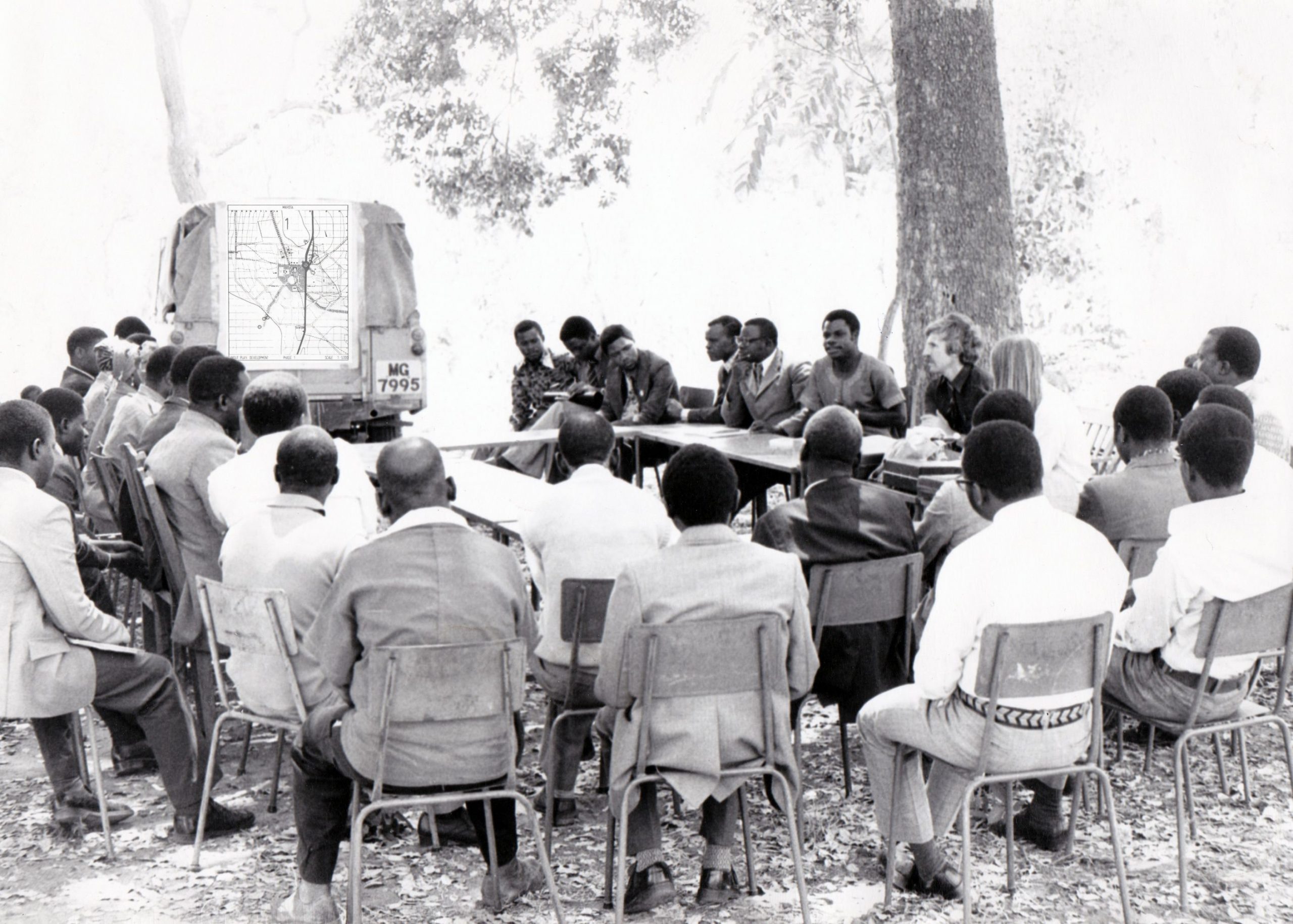
Presentation of planning concept with local leaders in Mkohta, Malawi, 1978 – foto © gerhard gross
The following paper was edited by APFEL GmbH, Berlin, in 1981 (html-version by gerhard gross)
Project Summary
Development Objective
Improvement of living conditions of the rural poor by developing social and technical infrastructure services in rural areas.
Immediate Objectives
-
- Satisfaction of basic needs
- Creation of income and job opportunities
- Spatial co-ordination of investment proposals
Long-term Objectives
-
- Reducing the rural-urban migration
- A balanced regional development
- Creation of a planning authority for rural areas
Approach and Strategy
Co-ordinated social and technical infrastructure programmes are to be designed and approved. Services will be centralized to increase efficiency and accessibility. The physical structures – RURAL GROWTH CENTRES(RGCs) – may comprise safe drinking water, primary health care, education and marketing facilities, etc. Within the project only core facilities will be constructed. Compatible and complementary government and non-government programmes affecting the rural sector are integrated, so as to reach agreed co-ordination towards an improvement of the selected areas.
Criterion
-
- Selected areas for the establishment of RGCs should have some kind of an agricultural or other economic potential
- RGCs should serve peripheral areas
- RGCs are to be the grass-root structure within a national settlement hierarchy
Project Design
-
- Employment of the quickest and most direct means to implement development proposals
- A reduced regional analysis focusing on specific items only, to assess the deficits and the development potentials
- Public participation during the planning phase and incorporation of self-help in the phase of constructing the centres
- An integrated approach to co-ordinate all activities in a spatial investment programme
The Scope
In order to assess the extent of the services to be provided and to observe the development of a spatial investment strategy, RGCs are launched as pilot schemes.
Part 1 – Introduction
The United Nations Centre for Human Settlements (HABITAT) defines the general objective and strategy for the development in rural areas as follows:
‚TO IMPROVE LIVING CONDITIONS IN RURAL SETTLEMENTS, WITH A VIEW TO REDUCING MIGRATION TO URBAN AREAS AND FOR GENERALLY IMPROVING THE QUALITY OF LIFE‘
This, of course, is a statement only, a task and has to be brought into existence by employing particular development components and a spatial and physical realisation. As for the part of APFEL GmbH, the question of improving the ‚quality of life‘ in rural areas can only be approached by an innovative concept which considers the variety of actual prevailing economic, socio-cultural and political conditions. Therefore a standard textbook can not be provided but a concept and method called ‚The Rural Development Centre‘ (RGC) has been formulated and materialized and reads as:
-
- satisfaction of basic legitimate social needs
- improvement of public technical infrastructure works
- supply and upgrading of community services
- creation of income and job opportunities
- establishment of produce and marketing facilities
This programme implies that the majority of the rural population has some means of income either in the traditional subsistence sector, as small-holders in the field of agriculture or in some modern agro-enterprise. RGCs do not interfere in the general employment sector, but make the necessary provisions for the socio-economic infrastructure needed to really improve the living conditions of the rural poor.
1.1 Development in Rural Areas
Rural areas used to develop spontaneously and without any organised involvement by policy-makers and planners. But, due to the general environmental problems and the particular rural-urban migration problem, the disproportionate and deteriorated symptoms of the present society have to be attended to seriously now.
In the past, the various development strategies put their emphasis on increasing industrial productivity and employment opportunities in the urban areas and the efficient exploitation of restricted resources. The rural regions have been considered as suppliers of food and raw material and therefore agricultural, mining and forestry projects are fostered. It has been assumed that partial progress of the industrial sector will eventually trickle down to even the remotest area.
Quite obviously this hasn’t worked out for the rural hinterland and only alien commercial, administrative and cultural networks have been superimposed onto existing systems and the balance of the rural society is disturbed. As a result an ever growing number of people can neither participate in the modern agricultural sector nor can they find support in the traditional community anymore. Subsequently the more flexible part of the rural population tends to abandon its place and to migrate into the urban environment. Disparity between the urban and rural areas is accelerating and a more equitable distribution of wealth is out of question.
In the light of these considerations, it is nowadays recognised that national development cannot continue without intensified use of the human and physical resources in the rural areas. Furthermore the fact has to be acknowledged that for the migrant population the available urban facilities are inferior and do not in any case provide tools for progress and prosperity.
The development of the rural region is the only alternative and neutralization of the urban-rural dichotomy the only way to arrest economic and social destruction.
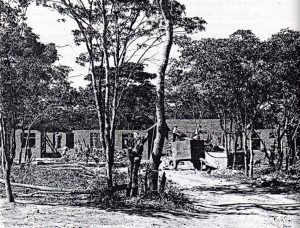
foto © marianne schellenberg
1.2 The Integrated Project Approach
A problem- and actionoriented integrated and co-ordinating planning approach with its valuable information on the actual sphere of influences and knowledge of the characteristic flow of economical and cultural forces in the development area, is the fundamental presupposition to identify strategy components and to assess their viability.
It appears that development is adequately described as the desire of the society to achieve an intensified utilization of restricted but available physical and human resources, implying that at present conditions such as employment opportunities, labour productivity and social facilities are unsatisfactory. Traditionally policy makers and planners try to solve the problems by concentrating on the various sub-systems and sectors independently and, more or less, hoping that the reform of the land tenure system for instance ,a development of the technical infrastructure or other items will eventually interlink for the benefit of the people. Apparently this hasn’t been achieved sufficiently and the sectorally determinated planning approach is under re-examination and new planning models are being developed.
This Integrated Planning Approach may briefly be described as follows: To co-ordinate all the ministerial planning activities such as Health, Public Works, Agriculture etc. (as the Horizontal Level) and to integrate the various actions from the local self-help organization up to a national rural development strategy (as the Vertical Level). Within the spatial, economic and social systems the deficiencies have to be determinated, development components and resources identified, their interdependencies within the sub-system in relation to the actual prevailing conditions in the area analysed and, setting up an order of priorities, the needs expressed by the local population converted into operations in accordance with the regional and national objectives.
This calls for new institutional structures, new implementation management and a new type of planning body. Once established, a dynamic interrelationship has to be enforced to ensure necessary feed-back and to maintain the subject.
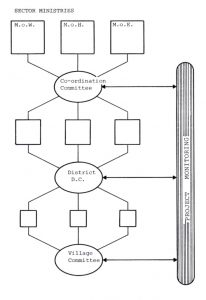
Part 2 – Objectives
2.2 Satisfaction of Basic Needs
Within the RGC concept ’satisfaction of basic needs‘ is defined as an approach of policy-makers and planners to put the emphasis on provision of basic social and technical services to those in need rather than to those who can afford them, since this problem cannot be simply solved by self-help activities.
During the phase of identifying the social and technical infrastructure services needed, two steps have to be distinguished: At first, within each particular location the population is asked and interviewed to propose their ideas on how to overcome the most obvious development restrictions. Then, the people are integrated into the development process and participate by their self-help, advice and recommendations in the implementation phase.
It is this stage which is very important in order to accelerate the existing development potentials and the human resources. The population has to be mobilized and integrated and only the bottle-necks of the development process are to be externally eliminated, to avoid – as much as possible – the character of a welfare project and to enable self-sustaining growth.
To satisfy the basic needs, the following are the physical aims:
-
- supply of a community social infrastructure to satisfy the needs for public services such as schools, health-posts, communication
- general improvement works of the technical infrastructure such as internal roads, water supply and distribution, drainage, etc. to maintain a certain physical standard essential to human dignity
- establishment of marketing facilities to have access to commodities
- promotion of employment opportunities in the non-farming sector e.g. small-scale enterprise, workshops, etc.
Now, after more than two years of experience with RGCs in which the inflow of capital and technical expertise has been joined with the participation of the people in the planning and implementation period, a noticeable achievement has been reached. In up to now economically and socially underdeveloped areas the population does identify itself with the RGC as a place where progress can be made. Life in the rural area served by the RGC becomes more attractive and people are less likely to migrate to the towns and cities.
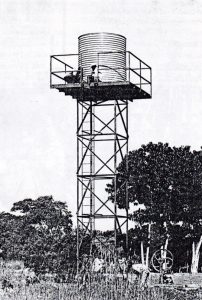
foto © marianne schellenberg
2.2 The Target Group
As a principle theme the RGC’s conceptional issues comprise the political assessment that only the complexity of the rural society can be defined as the target group. For operational purposes specific sections may receive intensified attention.
An analysis of the target group which will eventually benefit from the development proposals is of major importance in order to define the individual measures of the project. Apart from economic diversification (e.g. the Rural Poor) these analyses will include evaluation of existing social and cultural behaviour patterns, since the mobilisation of the people and their integration into development activities cannot take place in a cultural void, that is to say that the inherited social value- system relating to the new objectives is of utmost importance for the success of the project. This goes beyond the aim of only arresting destruction of the cultural heritage for preservation purposes but is an affirmation of the cultural identity of the rural population.
One of the questions is to asses certain contemporary attitudes and in this context the position of the rural women has to be investigated. In rural settlements in developing countries the problems caused by the lack of technical infrastructure are directly experienced by the women who carry the water for domestic consumption and spend many hours gathering firewood and fuel. Special provisions have to be made to take care of these particular constraints without destroying the integrated approach, which in itself does not allow for isolated programmes.
In order to satisfy the needs of the total target group the integrated rural development approach requires a differentiated mode of acting pertaining to the actual social preconditions, thus minimizing inevitable conflicts as much as possible. A redistribution of income, wealth and access to land and service facilities is only feasible if everybody gains something.
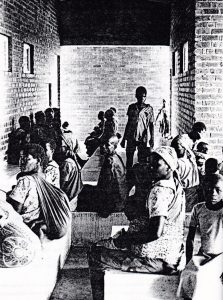
foto © marianne schellenberg
2.3 Balanced Regional Development
An inherited and inappropriate dissemination of service facilities and infrastructure in the rural regions constitutes a major constraint for an independent and dynamic national development.
The idea and the strategy of the RGC concept is based on the general understanding of the rural area as a system of microregions where each region has to be served by a centre actually providing essential services in varying sizes. The concept therefore implies a system of centres of different sizes. The quality of services differs with the magnitude of the region and therefore development proposals may commence with simple additions to existing structures and can go up to a comprehensive design for a completely new settlement. The latter, may apply to agro-industrial activities or complementary measures in the context of agricultural development works.
If the immediate objective is defined as to guarantee that the newly provided services will persuade the population to remain in the area by offering them ‚improved living conditions‘, the long term objective is:
to facilitate a weighed regional development by means of an adequate spatial structure of accessibility to services.
Since it is not all clear, and no standard check list can be provided, what pattern of sizes and locations of Development Centres would in fact be the most suitable for a particular region, any approach must be shaped as a pilot project type. This will enable continuous research and evaluation of any investment and will take the limited financial resources into account.
In order to set up a list of priorities in the initial phase, an identification key has to be formulated and may comprise:
-
- the region should be considerably less developed compared to the average national development level
- but, the region should already have been considered for improvement in the field of production within the national rural development policy
- and the location, as the potential Rural Development Centre should have at least some importance to the surrounding area because some rudimentary services are already offered
- populationwise the location should be at the basepoint of the national settlement hierarchy.
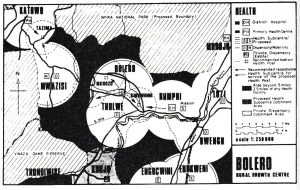
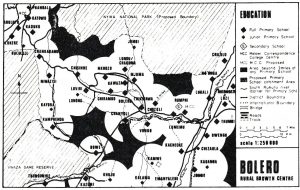
2.4 Co-ordination Planning in Rural Areas
A viable development programme has to be well integrated into existing planning institutions, must have a strong support by the central government and will establish a decision-making co-ordination committee.
One of the most crucial issues of the RGC concept is the coordination aspect, which is permanent ely met during the planning and execution of the programme. There are at least two complementary elements in this approach: First, integration by functional linkages between relevant components in the development proposal and second, integration by establishment of a multi-sectoral co-ordination committee.
The first item – the multi-disciplinary approach – demands a combination of socio-economic variables and techno-physical environment preconditions in the planning and the implementation process. Apart from the usual architects, planners and engineers who normally do the job, this task obviously requires social scientists and development planners, environmental planners (eg. forestry experts) etc.
The second item is the co-ordination task of RGCs. All the activities of multi-interest and multi-sector orientation have to be synchronised in relation to their spatial implications and all the concepts have to be pooled in order to achieve a coordinated development for the benefit of each particular subject. Requirements and proposals which will occur at the local level are preferable and have emerged because of the participation of the public.
A further component is the employment generating activity, which has to be linked and integrated with other proposals. Purely technological and social interventions would be bound not to be too successful. Investment that responds to employment needs – even in the rural informal sector – and intervention to serve the monetary requirements of the rural society (e.g. community based credit associations) are most crucial to rural development efforts.
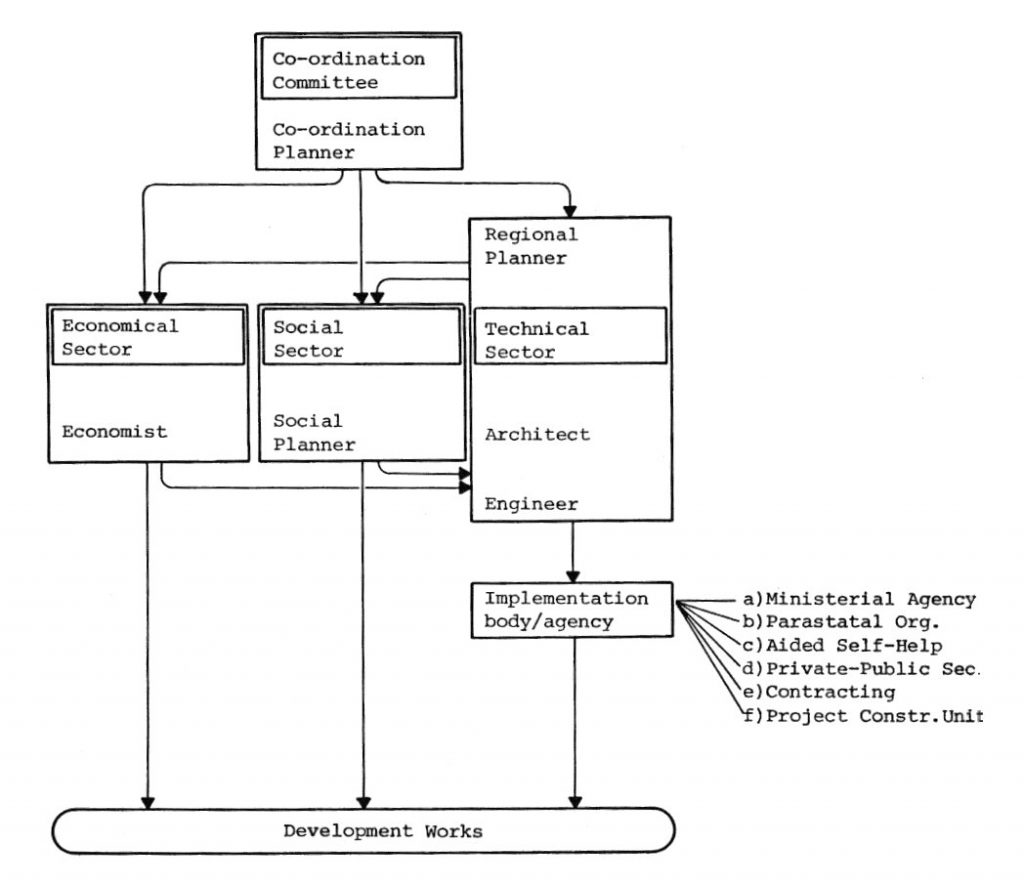
Part 3 – Execution of the Project
As mentioned in the introductory part, it is intended to assess the integrated approach to development in rural areas in relation to an ongoing project in Southern Africa. To distinguish the project’s aim from any agricultural project and to clarify that actually physical structures are needed for the ‚improvement of living conditions‘, the total of the activities involved are called RURAL GROWTH CENTRES. Choosing the notion ‚centre‘ implies the necessity of concentrating on focal points because of reasons of practicability, whereas ‚development‘ implies the existence of a process. The evolutionary element of the rural society in the RGC-concept is only stimulated and not at all absolute and static.
A summary of the project execution in short: The structure of the implementation of the proposals is problem-oriented and therefore closely linked with political, administrative, social, cultural and economic realities and requirements at the local level, thus eluding a production of ‚drawer plans‘. All the planning activities are action-oriented to minimize the time gap between research, analyses, selection of goals, means, planning and the final commencement of works at site. Due to these measures frustration of the local population can be avoided. Furthermore satisfactory co-operation with the national professionals and the local representatives of the development region produces mutual benefits, speeds up the planning and implementation process and eventually enables the Central Government to continue and to extend the RGC-Project into a national rural development programme complementary to an agricultural programme.
Finally two points have to be emphasised: First, for the success of an integrated rural development a conscious identification of the substantial elements of the proposal by the National Government is needed, calling for a strong ministerial coordination agency. Secondly, different locations and different economic and social data will always require an individual attempt and individual solutions.
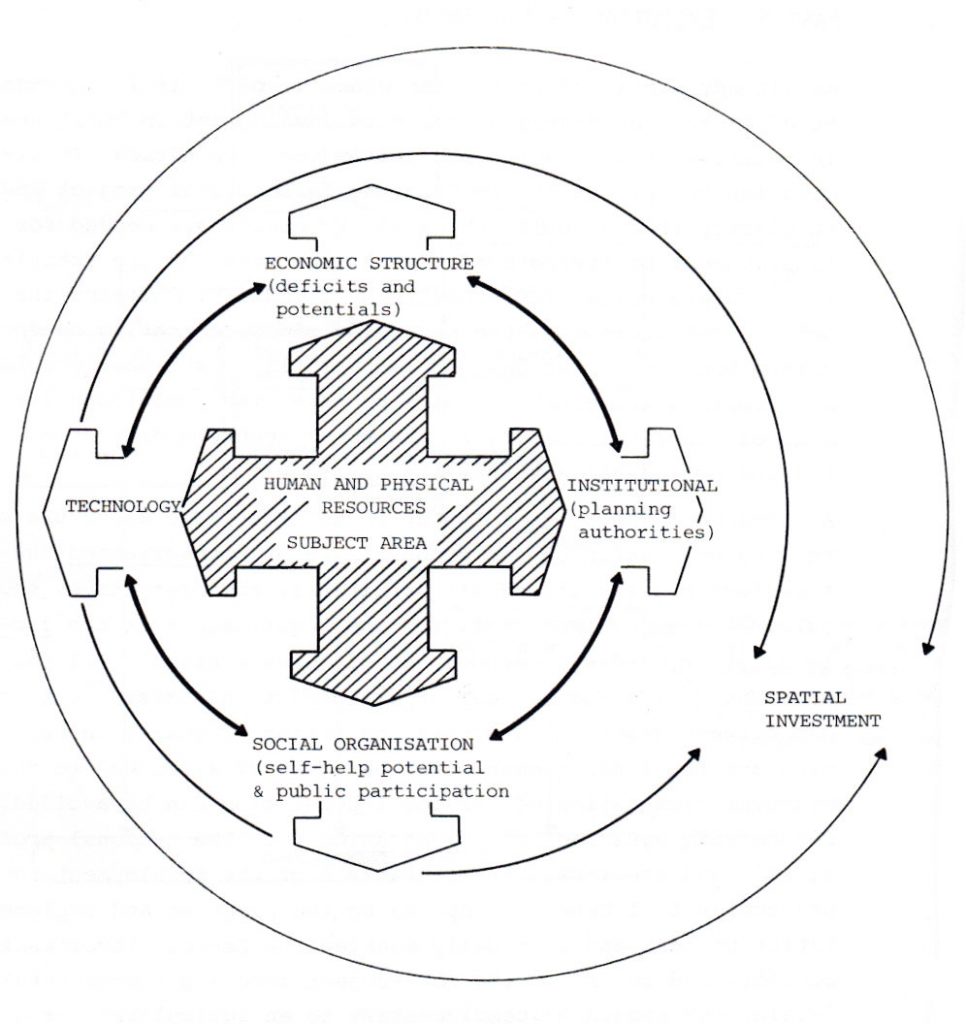
3.1 Planning Process
3.1.1 Regional Analysis
According to the terms of the project, the primary task – the regional analysis – focuses on specific items only and reflects the needs to cope with the urgency of problems at the local level and the limited financial funds for planning, implementation and operation. The contents are:
- identification of deficits in the provision of social and technical services in and around the proposed centre area
- Evaluation of development potentials of both agriculture and nonfarming acitivities such as small-scale enterprise and marketing
- Relation of the Rural Development Centre Project to other Government projects and activities going on in the area
The evaluation of the economic development potentials plays a key role in this context, as it not only determines the specific qualitative requirements of services, but also indirectly influences the probable future population growth which again determines the size and level of facilities required.
The analysis has been approached in three stages. The first and most important one involved the local community represented by Chief’s Village Headmen, Ward Councillors, Party Leaders,
MPs, Teachers, Medical Staff and others. All these representatives have been interviewed and asked about their views of the problems of the area and about their proposals for facilities required in a Rural Development Centre.
At the second stage the District Officials of all Ministries and Departments have been approached, to obtain more general information about regional development potentials. Finally statistical data, information on planning norms and ongoing programmes in and next to the RGC-area have been obtained from Ministries at Central Government level. As a result the following recommendations have been made:
-
- Proposals for service facilities in the RGC and its area
- Proposals for complementary measures in other sectors in the planning area, which are not covered by project funds and the ministries or donors asked to cover the costs
- Identification of possibilities to create and support non-farming activities in the RGC and overall planning area
3.1.2 Coodination Planning
The objective of the co-ordination planning part of the project is to enable a qualified and constructive participation of all involved Ministries in the planning and implementation process concerning the RGC proposal. The purpose of this is to elaborate the following:
-
- if there are any objections concerning the proposed development scheme
- will the various ministries agree to supply the necessary personnel for the operation of the intended facilities and are funds available for the recurrent costs?
- are the ministries resp. the specific beneficiaries of the future centre willing to continue to invest on their own in those essential fields, which are relevant for self-sustaining growth and development?
- can the physical development works be integrated into ongoing and intended programmes of the sector ministries?
In addition those complementary measures are co-ordinated, which are essential for the viability of the centre and which can not be financed by the project funds. These items are for instance general road access, afforestation programmes, transportation etc.
Continuous surveillance of the ’complementary measures‘ will eventually result in a regional co-ordination of the various development programmes, meaning that based on necessities, the tools have been created, to come to a spatially co-ordinated investment scheme: An integrated Regional Structure Plan.
To set up a co-ordination and decision making body, an Inter- ministerial Conference has been created and is now well established. All the ministries and organisations concerned are present and scrutinize, decide and follow up the proposals made for development. The decisions being made are obligatory to the ministries.
This conference is of far-reaching implications: A development proposal resp. project may be conceptually sound, but it will fail in the operational field, if it is methodologically weak:
The designation of a central body and an organizational framework endowed with sufficient authority and resources to plan and to implement development projects and the commitment of the Government and it’s institutions to rural development are of paramount importance.
3.1.3 Design an Realisation
Based on experience made in various projects, the RGC-concept intends from the very beginning to avoid the separation of planning and implementation. Therefore the organisation of necessary steps for the construction of the centres started parallel to the design work.
The physical structures absorb a considerable portion of the total project investment and, once constructed, are to last long and are difficult to alter. Therefore the question of the ’standards’ is a crucial one. For selection the following principles have been followed:
-
- The lay-out of the Centre and the individual buildings should reflect the psycho-social significance of physical development structures in rural environment. The population should be able to visualise the range of their communal development potentials and the facilities resp. the village lay-out should increase the attractiveness of the location.
- Since finances for rural non-farming development are generally rather limited, the item of the recurrent costs for later maintenance needs are of major importance. Building materials and design standards should be appropriate but only ‚permanent‘ structures for the communities facilities and the technical infrastructure are acceptable.
- In order to save planning time and to comply with existing construction experience of the local craftsmen and artisans, so called ‚Standard De- signs‘ have been employed. In a second stage of the development programme these drawings are scrutinized and, if necessary, adapted to new requirements and actual conditions.
For implementation of the proposals – for the actual construction – a variety of possibilities have been surveyed. There are:
-
- the traditional way of public tendering of the total of works
- the execution of works by the Ministry of Works
- a mixed system of public and private sector, whereas only machinery and heavy equipment are leased from a contractor, the manpower provided by the local community and supervision of works done by the Ministry
- the aided self-help
But, since the organisation of project should allow for as much self-help contribution as possible and the implementation body should be flexible enough to integrate these activities, an additional solution has been formulated: A project-related Construction Unit under the auspice of the project responsible Ministry. This Unit works even in the remotest parts of the country and has a skeleton crew of skilled craftsmen to be supplemented by
the local population if they have the required time and knowledge.
3.1.4 Rural Small-Scale Enterprises
To support a government in its social and economic objectives to raise the standard of living conditions of the rural population and therewith diminish migration into urban areas, further to the provision of social and technical infrastructure facilities, certain supplementary issues have to be fostered: Opportunities have to be investigated, to increase the individual income, meaning that the creation of sources of employment should have high priority.
Apart from the fact that the agricultural sector is undoubtedly the major field of rural income and employment, appropriate investment in human settlements can directly and efficiently improve the working conditions of low-income families and stimulate the development of various sectors. With regard to the ongoing achievements in the RGC’s in the range of health, education, water and sanitation it can be said that an increase in the working capacity of the local population will take place and therefore the necessity has emerged to actually create employment opportunities in small-scale enterprise and marketing.
The RGC-Project has up to now evaluated the possibilities and provisions have been made for workshops and similar facilities in the overall package of infrastructure improvement. They can be leased or rented to private individuals for their commercial purposes.
In addition to employment problems the question of improving rural nutrition is investigated. It is proposed to set up a scheme for ‚house gardening‘, which will at first supply the families with better food to overcome the widespread problems of malnutrition and second, will enable the women to produce a certain supply of vegetables for example for marketing purpose.
At present there is the demand on focusing on a more detailed analysis for non-farming activities in order to establish a long term development aid structure for the rural artisans, small-scale industry, marketing and the rural informal sector.
3.2 Construction Works
One of the most substantial presuppositions for a successful development which intends to integrate the public, is the fast reaction to the demands made known to the planner.
Physical construction works should commence as soon as possible to convince the people that progress is being made. Therefore the RGC-Project established a total of three independently working Construction Units to work in the North, South and the Central area of the country parallel. As mentioned in chapter 3.1.3 Design and Realisation, those Construction Units have proved to be the best solution. The possibility of giving the works to private contractors has been surveyed, but had to be ruled out because the contractors declined to tender because of the remoteness of the proposed locations. The chance to get the construction in total done by the Ministry of Works was too limited because of the ministries staff availability.
3.2.1 Self-Help Activities
It is not the intention of this brochure to discuss the general problem of self-help and popular participation but a few items may be mentioned: The usefulness of the peoples advice to the planners has been proved and the people’s participation in the works as being indispensable as well. But certain conditions have to prevail. One is the existence of a general organisation already formed by the people such as local council, co-operatives or rural workers organisation. Those organisations should not be imposed from above and should not be formed solely for the purpose of just the construction of some buildings for the RGCs. Another condition is the commitment of the works supervisory staff to peoples participation by accepting it in all its consequences. If the people are not encouraged in their activities resp. supported and even mistakes accepted as unavoidable, they will return into indifference and despair.
3.2.2 The Construction Unit
It appears to be important to describe in short the function of this unique implementation body. The same task, but under different preconditions will certainly ask for a different mode to execute the works, but the basic understanding of the RGC- concept is that an individual solution always has to be formulated to meet the individual needs.
Apart from the point of keeping a close relationship between planning and implementation activities and therefore a particular project should be under one responsibility as much as possible, the question of the actual construction costs played a major role in preliminary discussions: The proposed locations are scattered all over the country and since they are not always very accessible, the private contractor asked to execute the works didn’t come forward with great enthusiasm and reasonable prices.
Each Unit has got a skeleton crew of skilled labourers such as masons, plumbers and carpenters to do such works which require a certain standard of workmanship. Unskilled workers are required as much as possible from the area, where the construction takes place. The ratio of skilled to unskilled is approx. 40:60. The works are supervised by national and international engineers.
Where possible and sensible the works themselves are executed by means of labour intensive methods. This enables the local population to participate within the range of their capability.
Building materials are selected according to the following:
-
- appropriate technology
- availability
- preference of local to imported goods
- costs of production and costs of maintenance
To reduce costs of transportation, the bulk material such as claybricks, sand and gravel are of course produced next to the site.
Part 4 – Mbalachanda – A Rural Growth Centre
To verify the project aims and outcome, a comprehensive summary of the regional analysis for Mbalachanda area – as a sample – is given below, including the deduced proposals for development measures:
Socio-economic Characteristics of Mbalachanda Area
The economy of MBALACHANDA area of today is based on the production of flue cured tobacco. The large scale estate development on private enterprise base started in 1975. Up to now about 30 estates have been opened with the total acreage of about 44,000 along the westbank of SOUTH RUKURU River.
The production method on the estates is labour intensive. The employment is based a hired labourers system. The majority of the labourers are recruited from outside the area. This has resulted in a high influx of people to the area. Most of the labourers come for seasonal work only. Accordingly the rate of families is low and the population structure is unbalanced.
Before the estate development started the area was sparsely populated with huge areas of flat, uncultivated bushland and was remote from the point of access. The economy of the population living there was dominated by agricultural subsistence production. In the past a high out-migration especially of male persons in the working age group took place to other parts of the country and abroad in search of better employment. The major constraints of agricultural development were lack of water, lack of infrastructure and agricultural services.
With the estate development the economy of the area has changed considerably towards a cash crop and monoculture production. As a result the population in the area has trebled since the 1966 census to a total population of approx. 15,000 at present.
Further extensions of the estates are likely to take place because of uncultivated land still being available in the area and also because of the existence of further applications for estate land there.
Major constraints of the MBALACHANDA estate development in the long term are firewood supply, water supply and communication services. For example, under the given circumstances the estates are only able to operate up to 8 or 10 years with the given amount of firewood.
Apart from the estate development the economy of the area will be strengthened by agricultural projects aimed at the smallholder development and carried out by the Malawi Government such as the Mzimba (Rukuru/Kasitu) Rural Development Project and the North West Mzimba Smallholder Settlement Scheme.
The estate development, however, might limit the amount of additional land that can be used for smallholder agriculture in the area of SOUTH RUKURU River.
Provision of Services in the Areas
The estate development has not been accompanied by the provision of sufficient social and other infrastructural basic services.
The living conditions of the estate employees are poor in the field of housing, water supply, health, education, supply with food, other home consumption goods and any other communal and recreational facilities.
Only some schools, markets, shops and bars exist along the road parallel to the SOUTH RUKURU River. Up to now people from the area mainly depend on the service centre at EUTHINI across the river.
Public transport is not provided. The feeder roads are of low standard. The only bridge across SOUTH RUKURU River is the VUVUMWE Bridge about 14 miles south of MBALACHANDA site.
For the smallholders provisions for agricultural services will be made under the National Rural Development Programme (NRDP)
Function of the Rural Growth Centre
The new MBALACHANDA RGC will provide the basic services lacking in the area in terms of social and other infrastructural facilities in order to improve the living conditions of the population, i.e. mainly the growing number of estate labourers, and to support the economic development taking place there.
By this the RGC pursues the following basic objectives:
-
- to provide the basis for the settlement of a permanent labour force
- to stop the out-migration from the area and
- to support non-farm activities and small-scale industry.
The RGC will be the major central place for the whole area west of SOUTH RUKURU River. The population expected to use the facilities of the RGC is at present probably well above 15,000 and will have increased to more than 40,000 in 1985.
In order to provide a more balanced service centre network and reduce travel distances, local sub-centres to the north and south of the RGC should be strengthened.
List of facilities for the Rural Growth Centre Mbalachanda
8 classrooms for the F.P. School 1 administration block for the F.P. School (including teacher’s office, library, store)
1 health subcentre (dispensary and maternity unit)
1 guardian shelter
1 community centre (including home economic unit)
1 resthouse
1 produce market (including a butcher’s shop and a slaughter slab)
3 service industry workshops
1 post office
21 staff houses
Complementary Development Measures required:
-
- Housing Programme
- Afforestation Programme
- Long term water supply
- Telephone services
- Roads improvements
- Bridge across SOUTH RUKURU River
- Bus Service
- 1 ADMARC market at the Rural Growth Centre
- 2 Health Posts and 1 Primary School in the surrounding area.
As for all centres, services will be provided such as:
-
- water supply (boreholes, watertanks, watertaps, etc)
- internal roads and drainage
- sewerage
- sportsground / playground
- equipment up to 10% of building costs
Prospects
The overall perspective is at present that the Government of Malawi and the Government of the Federal Republic of Germany commonly agreed to evaluate the possibility of converting the pilot RGC-Project into a National Programme.
Sectorally determinated activities of the ministries are supposed to be shaped and bundled up into a spatial system to furnish Malawi with a network of Rural Development Centres.
Provisions are herewith made that for further development and satisfaction of ‚basic needs‘ the total population will have the basic social and economic infrastructure facilities at its disposal .
A National Rural Growth Centre Programme (RGCP) has to be created in close relationship to the National Rural Development Programme (NRDP) which in itself is agriculturally oriented. Only a well tuned infrastructure development scheme will make the best of the available resources.
Both programmes therefore represent the essentials of an integrated rural development.
© APFEL GmbH Berlin 1981